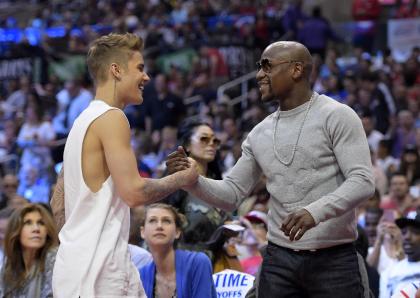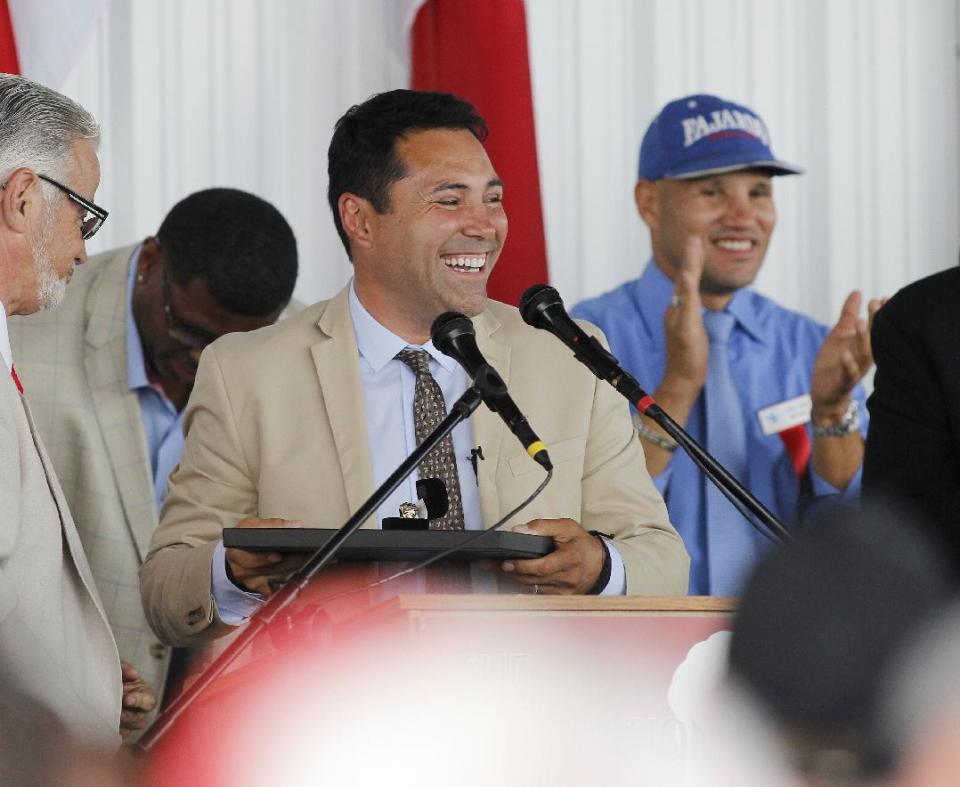Suddenly, the pressure rests squarely on Oscar De La Hoya's shoulders

Canelo Alvarez has a difficult challenge ahead of him when he meets Erislandy Lara in a pay-per-view bout in Las Vegas on July 12, but there is no question that his mentor/idol/promoter, Oscar De La Hoya, faces the most pressure to perform.
De La Hoya is tasked with hawking Alvarez's pay-per-view during a period in boxing when pay-per-view sales have dipped noticeably.
Three of boxing's greatest stars have already fought on pay-per-view this year, and in their own way, the numbers for all three were disappointing.
Manny Pacquiao defeated Timothy Bradley on April 12 in Las Vegas in a bout in which promoters were insisting Pacquiao had a shot to sell 1 million pay-per-views. The final number turned out to be about 775,000.
Pay-per-view's greatest star, Floyd Mayweather, faced Marcos Maidana on May 3 in Las Vegas. Coming off of a 2 million-plus pay-per-view against Alvarez, the Mayweather-Maidana fight sold roughly 900,000.
On June 7, Miguel Cotto lifted the middleweight title from Sergio Martinez. Promoters had been hoping for 500,000 on pay-per-view, but settled for around 350,000.

Though the numbers are, in all three cases, below expectations, they still generated enormous amounts of money and shouldn't be dismissed as abject failures. At 900,000 sales at an average price of $70 (halfway between the $74.95 cost for the HD version and the $64.95 cost for standard definition), the Mayweather-Maidana fight generated roughly $63 million. (Editor's note: Showtime has not released the actual number for Mayweather-Maidana, but industry sources have pegged it at 900,000).
Of that $63 million, half, or $31.5 million, would go to the promotion. That's a pretty good haul.
Even the Cotto-Martinez fight generated a little more than $15 million in pay-per-view revenue.
It's not like those fights were bombs; they simply weren't the massive hits that were expected.
Pay-per-view is a tough business even in the best of times, but in a crowded marketplace with more intense competition than ever, it's harder to ask the consumer to continuously reach into the wallet.
There were distinct problems with each.
The fans had made it clear they weren't interested in seeing Pacquiao-Bradley II given what they'd seen in Pacquiao-Bradley I. Most people felt Pacquiao had won that fight decisively and didn't need to see a rematch. A segment of the populace felt the first fight between them was fixed and wouldn't buy at any cost. And then the HBO 24/7 series on the fight was the worst ever produced for a pay-per-view fight. It did nothing to spur pay-per-view sales.
The Mayweather fight got a late start, having been announced about two months ahead of time, the bare minimum required to promote a fight of that caliber. There was no early push, like there was when Mayweather and Alvarez went on a nine-city, cross-country tour to push their bout in the summer of 2013. Few were giving Maidana a chance. And then, the night before the fight when a gloves controversy developed, Mayweather's team publicly said the fight was off. None of that helped sell the show.
The Cotto-Martinez fight was killed by competition. California Chrome was going for the Triple Crown in the Belmont on the same day. It was a major story across the country and particularly in New York. The fight got far less television news coverage in the buildup in New York, where a large population of Puerto Ricans reside who may have bought the fight to support Cotto. The New York Rangers were also in the Stanley Cup finals, further reducing the fight's presence in New York.

All of this leads up to the challenge facing De La Hoya: He no longer has Richard Schaefer, Golden Boy's former CEO, or Bruce Binkow, its marketing guru, to rely upon.
Alvarez is clearly one of boxing's biggest star, but the fight features a pair of non-English speakers. That would be OK if both fighters had the reputation of being exciting. Lara, though, has developed a reputation as boring, even though several of his recent fights were highly entertaining. His bout last year with Alfredo Angulo was exceptional, but people can't seem to forget the fight he had with Vanes Martirosyan.
There have been very popular fights that involved non-English speakers in both corners, but few have ever done extraordinary numbers.
It was Schaefer who ran the business from the company's inception and who made a series of excellent decisions that pushed Golden Boy to the top of the mountain as far as boxing promoters go.
Much of the staff remains, though De La Hoya has trimmed it of a number of Schaefer loyalists.
So it's going to be De La Hoya's job to persuade a public that hasn't been willing to open its wallet to do so for Alvarez-Lara.
De La Hoya is an affable guy when interviewed, but he doesn't have the sales sense that Schaefer had. Nor is he as accessible to the media as Schaefer was. A reporter who called Schaefer looking for an interview would regularly get a return call by the end of the day. And he returned calls from reporters not only at the top websites and the biggest newspapers, but from the smaller, boxing-only websites, as well.
That led to a steady stream of conversation in the media about the fight he was trying to sell.
De La Hoya, as a celebrity, isn't nearly as accessible. Reporters from the top outlets can get him, but it's far from a sure thing to be able to get him the same day, the way one could with Schaefer, or with Top Rank's Bob Arum, or even Mayweather Promotions' Leonard Ellerbe.
Those from the smaller websites have next-to-no chance of getting De La Hoya in any situation other than a scheduled, public session. That limits the flow of news content.
As a fighter, De La Hoya was the best PPV salesman in the game, without question. He parlayed his good looks, his ability to speak Spanish and English, and his Hall of Fame fighting ability into a career as the dominant PPV force of the late 1990s and early-to-mid 2000s.
Mayweather's biggest pay-per-view number came against De La Hoya, and Mayweather became a superstar following that fight.
Pacquiao's biggest pay-per-view came against De La Hoya.
So, too, did Bernard Hopkins', Shane Mosley's and Fernando Vargas'.
There's a lot on the back end that the public doesn't see, though, that has to be done to guarantee the success of a pay-per-view. Now, those details are De La Hoya's concern.
He's going to be hugely in demand next week. Some will want to talk to him about Alvarez, and others about his relationship with Schaefer. But De La Hoya is going to be one exceptionally busy man.
It's not to say he can't do it, but it's going to take a lot of work, a lot of ingenuity, and frankly, a great deal of luck.
If the fight does 300,000, it should be considered a success. But as Cotto-Martinez showed, that's a hard number to hit.
There's no question that the man with the biggest challenge and the most pressure next week will not be either Canelo Alvarez or Erislandy Lara.
Rather, that distinction falls to the promoter, Oscar De La Hoya, who has to prove he can successfully navigate the choppy pay-per-view waters as well as Schaefer regualrly did.



